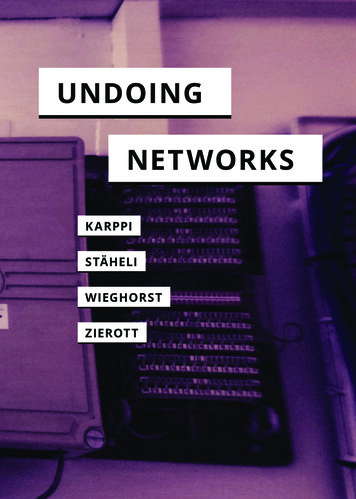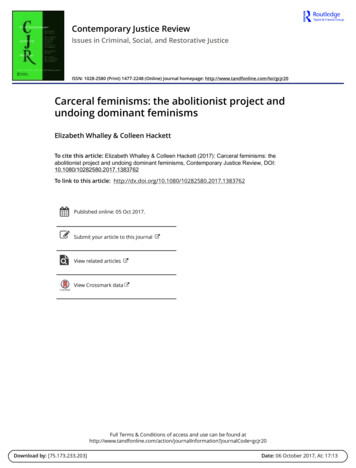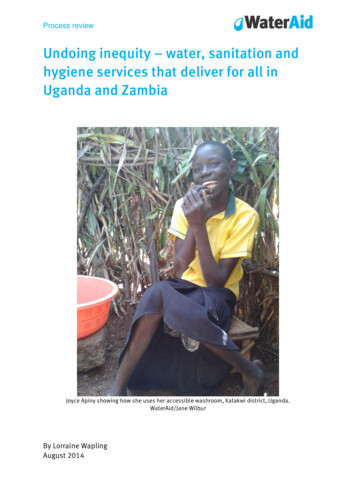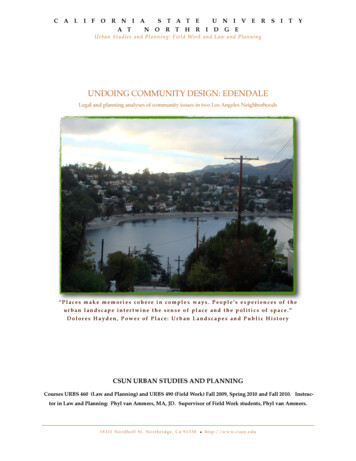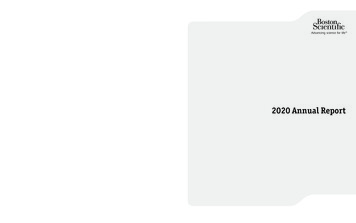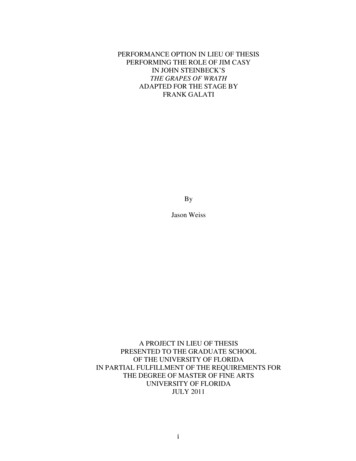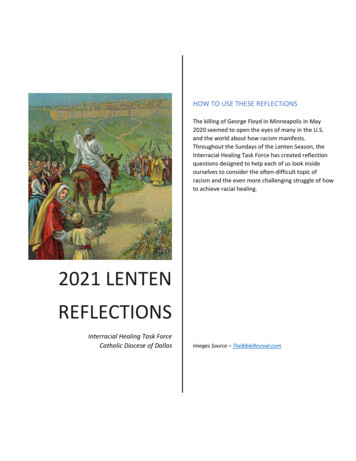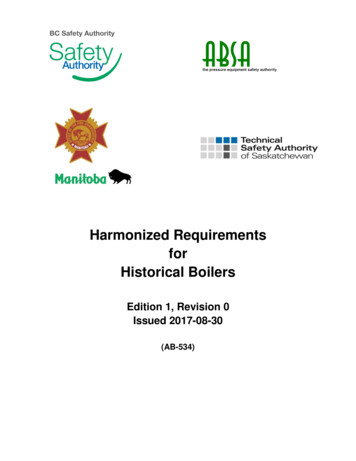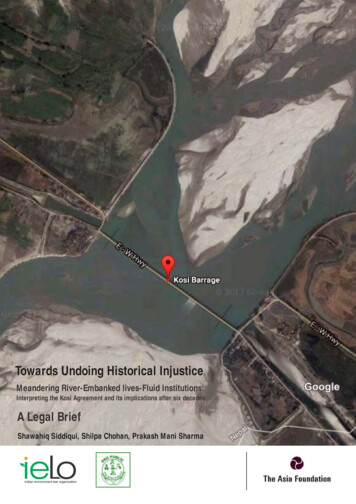
Transcription
Towards Undoing Historical InjusticeMeandering River-Embanked lives-Fluid Institutions:Interpreting the Kosi Agreement and its implications after six decadesA Legal BriefShawahiq Siddiqui, Shilpa Chohan, Prakash Mani Sharma
AcknowledgmentsThis Legal Brief is the product of collaborative effort of Indian Environment LawOrganization, Forum for the Protection of Public Interest (Pro Public) and several CivilSociety Organizations and groups working on the grassroots in the shared Khado RiverBasin in Nepal and India; Special gratitude is extended to Shri Pancham Bhai and Mr.Ranjiv Kumar for facilitating and conducting the India-Nepal Gram Shivir (communityconsultation) and contributing to the deliberations while preparation of this Issue Brief.The team would especially like to thank all the CSO members involved in the Project inthe shared Koshi Basin in Nepal and India that produced reports of the communityconsultations held in the villages that provided tremendous input for the preparation ofthis Issue Brief. Special thanks are due to Dr. Tira Foran of CSIRO, external advisor to theproject, for his guidance, especially in the early stages of the Project. The Authorsgratefully recognize the collaboration and contributions of many people who directly orindirectly assisted in preparation of this Issue Brief. The views presented here and anyerrors are the sole responsibility of the Authors and should not be attributed to otherindividuals or institutions acknowledged above.This Legal Brief has received support from the UK Department for InternationalDevelopment (DFID) and The Asia Foundation. However, the views expressed within donot reflect their views or opinion or official policy. The boundaries, colours,denominations, and other information shown on any map in this work do not imply anyjudgement on the part of the Authors or the institutions referred herein concerning thelegal status of any territory or the endorsement or acceptance of such boundaries.Rights and Permissions:The material in this work is copyrighted. Indian Environment Law Organization, Indiaand the Forum for the Protection of Public Interest, Nepal encourages dissemination ofthis work for bonafide purposes and will not require any prior permission fromwhosoever may be concerned.Queries may be addressed to:Indian Environment Law OrganizationH-383, Palam Vihar, Gurugram, Haryana,E-mail: ielo.indialaw@gmail.com 2017 Indian Environment Law Organization, India and the Forum for the Protection ofPublic Interest, NepalFirst published, 2017Photo Credits:Pancham Bhai, Shilpa Chohan, Shawahiq SiddiquiPrinted at:The Printing WalaWebsite: http://theprintingwala.in
Key MessagesŸThe permission accorded by Nepal to construct Kosi Project on Nepalese territory is a valid exerciseof sovereignty under international law and it cannot be challenged on grounds of legality (as was thepopular sentiment in Nepal during 50's and subsequently). However, terms and conditions overwhich the permission was granted can be viewed from the perspective of Nepal's position underinternational law.ŸOstensibly, the Revised Kosi Agreement, 1966 was effected with the view to provide, primarily floodcontrol among other perceived benefits. However, the Agreement has no specific clause on floodcontrol mechanisms or monitoring and compliance mechanisms in cases of actual or anticipatedflood and breaches/failure of flood control structures. In short, the possibility of future floods wascompletely overlooked and the Agreement is completely silent on mechanisms that would addressfuture floodsŸThe terms of the Revised Kosi Agreement, 1966 clearly indicate that calculation and accounting ofbenefits that would accrue to both the countries from the Project, was not sufficiently attempted andtransparently conveyed.ŸThe popular myth that by virtue of 1966, Revised Agreement Nepal's freedom to develop the KosiRiver was compromised by the terms of the Agreement is not true. The Revised Kosi Agreement vestsall the power to withdraw for 'any other use' Kosi waters within the entire Kosi Basin in Nepal(Article 4 (i)). In fact the 1966 Agreement reaffirms Nepal's water right over the entire Kosi Basin inNepal thus limiting India's claim based on chronology of use or absolute riverian integrity.ŸThe life of lease period under the 1966 Kosi Agreement far exceeds the usual trend under watertreaties agreed globally. Throughout the life of the lease (199 years: Article 5 (i)), the value of landwill not increase either by inflation or otherwise as per the letters exchanged as integral part of theRevised Kosi Agreement (The letters exchanged between HMG and the Union, December 19, 1966)ŸThe power and navigational benefits for Nepal under the 1966 Agreement are illusionary. There isno obligation on India to generate any electricity from the Kosi Project. The obligation is to provideNepal with a percentage of any power that 'may be generated'. Similarly, navigation has been madesubject to technical feasibility and upon grant of special permits by Nepal in discussion with theExecutive Engineer, Barrage (Article 10). The position with respect to fishing rights is similar ongrounds of safety (Article 11).ŸThe institutional design under the Revised Kosi Agreement, 1966 ensures that Nepal is bereft of anyresponsibility for all important practical purposes, despite the barrage and embankments located inits territory and as sovereign government it being responsible for the safety and well being of itspeople.ŸLocal governments of the two countries are no where represented in the AgreementŸThere is complete lack of vision in the Agreement on the aspects of ecological needs of river,biological diversity and climate change. The social impact assessment and right of rivercommunities in India and Nepal have completely been overlooked, rendering them victims of firstjoint venture water resource development project on an international river in South AsiaŸThe Kosi Agreement, 1966 was renegotiated and revised as per the compelling circumstances andunderstanding of both countries at that point in time and this can only be undone by reachingenhanced understanding over a new Agreement or by modernizing the existing Agreement of 1966.
1CONTEXT ANALYSIS1. Introduction - Indo-Nepal Rivers arelinked to Potential International WaterRights:structural control measures.2. Ecological context of Kosi:The larger Ganges River System isKosi is the largest river of Nepal and it is thesupplemented by the flow of remarkablelargest tributary of Ganges. The River flowsendowment of smaller rivers that flow throughthrough a narrow gorge of 10 km before enteringNepal draining mountains, foothills and vastplains of Chatra. After flowing 25 km in Nepal, itexpanses of Terai. These rivers form major riverenters India near Hanumangarh and flowsbasins of their own that together constitute thefurther downstream to join Ganges in Kursela inlarger Ganges basin shared by China, India,the state of Bihar. The River is known for itsNepal and Bangladesh. Since almost all riversdevastating effects, often changing its courseflow in or out of Nepal,since last 250 years. Thethey are inherently linkedriver as per experts hasThe Design of the Kosi Project intended to yieldmulti-purpose benefits. The construction worksto potential internationalbeen shifting westwards, abegan after the signing of the Agreement betweenwater rights issues withtrend which has beenthe two countries in 1954. The 1,150 meter KosiNepal's upstream andreversed in the year 2008Barrage, intended to serve as a gradient controldownstream neighbours,whereinthe Kosi is nowmeasure for containing the meandering behaviourof Kosi, was built in Bhimnagar, (8 km insidewith India being the largershifted 120 km eastwardsNepal). Two canals take off from either side of thedownstream riparianand is understood to flowbarrage. The Eastern Main Canal, which is entirelyaccounting for largeinits 300 year old bedin the Indian Territory, provides irrigation tovolume of water that flowswhichwas abandoned due612,500 hectares of agricultural land in India.'' Afrom upstream Nepal.tothewestwardshift in thepower house with an installed capacity of four unitsof 5,000 kW each is located along the canal at aKoshi River System is onecourse of the river. Duringdistance of 11 km from the barrage and generatessuch example of a sharedthe 1950s this trend ofpower by making use of the head drop of the canal.sub-system of the largerKosi was seen as aThe Western Main Canal traverses a distance of 35Ganges Basin linked with“strange difficulty thatkm in Nepal before entering the Indian Territory,and provides irrigation water to 11,300 hectares ofinternational water rightsarises every year in someagricultural land in Nepal and 356,610 hectares ofof upstream andparts of Bihar, bringingagricultural land in India. Flood control works indownstream neighbours.disasterand ruin1”Nepal consist of a western afflux bund about 2 kmIndia and Nepal havelong and a 40-km embankment along the easternsigned a formal instrumentbank of the river. Extensive embankments, about3. The Kosi Project- A220 km long, were built on either side of the river inof cooperation for themultipurpose jointthe Indian territory to confine the river flow andestablishment of aventure by India andprotect the land beyond from flooding. (Source:mutually benefittingNepal:Saman MA and Uprety Kishore, 2003)multi-purpose project onthe Kosi River in Nepal.The Kosi Project was theThe Kosi Project, however, has not only failed tofirst joint venture project of India and Nepal inachieve the objectives for which it wasan international river shared by them. It wasestablished namely flood control and irrigationpresented as a mutually benefittingbut by way of its embankment scheme hasMultipurpose Scheme to both countries oncompletely altered the local ecology and contextvarious accounts2. The benefits that wouldof the area in which it was established. It isaccrue from this development project includedtherefore desired to revisit the Agreement toflood control, irrigation and hydropower.understand its relevance and implication of itsHistorical accounts suggest that the idea ofprovisions in the present context of disasters,tapping Kosi waters was discussed as early as inpoverty, and further loss of productive land,1896 but in the absence of any serious feasibilitysiltation and the ever rising river bed due tostudies, no decision could be made3. Theconfinement of the Kosi River by way ofchanged political situation in Nepal in 1951, it is1. Works of Jawaharlal Nehru; March 1, 1951 to June 30, 1951), edited by S. Gopal, Second Series Volume 16, Part 1, pp. 17 30), cited in Arvind Panagariya, ConsensusBuilding and Nehru as quoted in Salman and Uprety, 20002. The Central Water and Power Commission of the Government of India prepared a scheme for harnessing the Kosi River that received the sanction of the Governmentof India in 19533. Dixit, Ajaya, Water Nepal, ed. 1994 Vol.4, No.1, at 140.
argued, enabled India to direct the attention tothe Kosi Project. The Multi-purpose Scheme, aswe shall see later in details, received the sanctionof the Government of India in 1953, followed bythe endorsement by the Nepalese Government.These developments led to the negotiations andsigning of the Kosi Agreement, 1954 betweenIndia and Nepal4. The Agreement was laterrevised in 1966 on the request of Nepal due to'changed circumstances'. Thus the Revised KosiAgreement, 1966 underlines the understandingbetween India and Nepal on implementing the5Kosi Project .4. From the Kosi Agreement, 1954 to theRevised Kosi Agreement, 1966:The Kosi Agreement 1954 and commissioningof the work for the Kosi Project attracted sharpcriticism leading to widespread resentment andNepal. Major criticisms were on grounds ofsovereignty and inadequate compensation toNepal. The discourse then grew in a way thatcritics asserted that the Kosi Project did notbenefit Nepal in any manner whatsoever andthat it granted extra-territorial rights to India tofurther India's own interests in lieu of minisculebenefits and at the cost of loosing Nepal's fertileland. Consequently, the work on Kosi Projectwas suspended during 1962-63. The criticismfor the Kosi Project and the Kosi Agreement ledto the deterioration of relationship between thetwo countries and mounted pressure on India toundertake 'extensive revisions' of the 1954Agreement which was done in 1966 and theamended Kosi Agreement, that completelyreplaced the earlier one, was brought into forcewith immediate effect after the signature of boththe parties.The Kosi Agreement, 1954 clearly outlined themulti-purpose ambit of the Kosi Project.However, the Project continued to be perceivedas a flood control project with the aim to reducethe devastation caused by recurrent floods in thetwo countries. The barrage and the Eastern MainCanal were completed in 1962. The constructionof the Western Main Canal started in 1972 and itbecame operational in 1982.4. see also for detail on the origin of the Kosi Project, Dinesh Kumar Mishra, "Refugees of the Kosi," in Himal South Asia, August 20005. See also, Agreement on the Kosi Project, Kathmandu, April 25, 1954 signed by Gulzari Lal Nanda (India) and Mahabir Shumsher (Nepal) (hereinafter 1954Agreement). For the text of the Agreement 56/Revised Agreement on Chose Project Annexure Agreement 25 April 1954 as accessed on 7.11.2017 at21.23 IST; also available on on-Nepal-and-india-Koshi-river-1966.pdf6. See B. G. Verghese and Ramaswamy R. Iyer, eds., Harnessing the Eastern Himalayan Rivers: Regional Cooperation in South Asia (Delhi: Konark, 1994)
2UNDERSTANDING THE REVISEDKOSI AGREEMENT, 19661. Preambular Ambiguities:The 1966 Agreement7 asserted that 'Nepal hadsuggested revision of the said Agreement inorder to meet the requirements of the changedcircumstances," and India, "with a view tomaintaining friendship and good relationsubsisting between Nepal and India," had agreedto the revision of the 1954 Agreement8. What isnoteworthy here is that the revision did notacknowledge the contentions raised by Nepal ondisproportionate benefits that would accrue toNepal, during the first 10 years of subsisting ofthe Kosi Agreement, 1954.2. Post Facto Regularization of the worksalready completed:By the time Kosi Agreement was revised,various works in respect of the Project werealready carried out by project executionagencies. For works that were at various stagesof completion, Nepalese Government 'agreed toafford necessary facilities', an important clausefrom the negotiating stance, contained in the1966 Agreement. However, the general layoutof the Kosi Project was slightlymodified and details in the form anAnnex were made part of the revisedagreement9. The issues regardingwork to be carried out in Nepal byIndian agencies, a twofoldmechanism was inserted. Forundertakings and other worksconnected with the Kosi Project,needed to be planned and carried outin consultation with the Governmentof Nepal; and works andundertakings that required priorapproval of the NepaleseGovernment would be implementedonly after such approval has been10secured . There are two elementsworth noting here. First, that evenplanning was to be jointly carried outby the designated agencies of the twogovernments. Second, the subproviso to the main provisionprovides that in the events whereconsultation with the Government ofNepal or his prior approval isrequired and for the matter related landsubmergence and compensation, intimation toHMG shall be sufficient11.3. De-linked and dysfunctional institutionalarrangements:As per the 1966 Agreement the execution of theKosi Project is the responsibility of the stategovernment of Bihar which is the designatedChief Engineer of the Kosi Project. By virtue ofthis, for all practical and operational purposes,from surveys to afforestation programs, soilconservation measures and afforestationprograms “required for a complete solution to12the Kosi Problem in future ” Government ofIndian state of Bihar became the chief executingagency of the Kosi Project in the Project Area13.While all surveys were to be carried in'cooperation' with Government of Nepal14,surveys and investigations necessary for generalmaintenance of the Project shall be carried outwith due intimation to the Government of Nepal.Institutional framework on the Kosi ProjectSource: Shrestha Rashmi Kiran etal, EPW (2010)7. Revised Agreement on The Kosi Project, Kathmandu, December 19, 1966, signed by Shriman Narayan (India) and Y. P. Pant (Nepal) (hereinafter referred to as the1 9 6 6 A g r e e m e n t o r t h e r e v i s e d A g r e e m e n t ) . F o r t h e t e x t o f t h e A g r e e m e n t , s e /Revised Agreement on Chose Project Annexure Agreement 25 April 1954 as accessed on 7.11.2017 at21.23 IST also available on on-Nepal-and-india-Koshi-river-1966.pdf8. See Preamble to the 1966 Revised Agreement. Available at on-Nepal-and-india-Koshi-river-1966.pdf9. Article 1 (ii), the Revised Kosi Agreement, 1966. For details Also see the Annexure-A to the Revised Agreement, supra 710. Proviso to the Article 1 (iii) 11. Article 1 (iii) 12. Article 2 (ii) 13. Article 2 (i), Project Area under the Revised Agreement means area acquired for the Project14. Article 2(i) (ii) (iii)
4. Reciprocity in data sharing:The data, surveys and investigations carried outby or on behalf of India in respect of Kosi inNepal is to be made available to the Governmentof Nepal without any delay. Similarly, theGovernment of Nepal is also required to makeall the data available to the Government of Indiaon request in respect for Kosi in Nepal15. Whilethe data sharing is based on the principle ofreciprocity, it is only the data for the Kosi inNepal which can be shared. There is noprovision for sharing of data with respect to Kosiin India.5. Land, Lease and compensation:With respect to use of land and other propertythe 1966 Agreement provides that when anymajor work which is not part of the amendedplan is to be undertaken, the approval is to begiven by the Government of Nepal as when thework receives the sanction of the IndianGovernment and notice has been given by Indiato Nepal16. The land required for projectpurposes shall be acquired by the Governmentof Nepal and the Government of India shall paycompensation, to be decided mutually, for theland so acquired for project purposes.The Project Area which includes all the arearequired for the project and additional worksthat may arise from time to time within themeaning of clause Article 2(i) and Article 3 forall practical purposes was to be acquired by theGovernment of Nepal and leased to theGovernment of India for a period of 199 yearsfrom the date of the signing of these agreementsat a nominal rate to be mutually agreed by bothcountries. There is also a provision for therenewal of leases on a mutually agreed basis17.The lands leased as Project Area shall continueto be under the sovereign jurisdiction ofGovernment of Nepal, and law of Nepal shallcontinue to be applied unimpaired on suchleased lands.The compensation for land and other propertywas to be provided for the loss of land revenueand for the land and other properties that wouldbe submerged. The compensation to be paid incash was to be determined as per themethodology provided in the revisedAgreement. The 1966 Agreement provides thatfor the purpose of assessing the cashcompensation, lands required for the executionof various works and submerged lands will bedivided into four classes to include: (i)cultivated lands, (ii) forest lands, (iii) villagelands and houses and other immovable propertystanding on them, and (iv) waste lands18. It isfurther provided that all lands registered in thecadastre in the territory of Nepal actually19cultivated were deemed to be cultivated lands .What emerges from this methodology is thatNepal was to be compensated for loss of revenuedirectly by way of cash and individual owners ofland and other immovable property were to becompensated through the Government of Nepal.The assessment and manner of payment ofcompensation was to be done by mutualagreement of both the governments and theassessment of land was also to be carried out byduly authorized officials of Nepalese and IndianGovernments20.The Revised Agreement does not containexplicit provision on the rate of compensation ofloss of land and other property. This was agreedby exchange of letters. For land that was alreadyacquired for the Kosi Project, India would paycompensation at the rate of five Nepali Rupeesper Nepali Bigha21. For lands to be acquired inthe future, and especially for the Western KosiCanal, the existing provision would beapplicable, under which loss of land revenue isto be determined on the basis of the land revenuepayable as at the time of acquisition of the land.6. Water Rights in the Kosi River:Right to use water in the Kosi Basin is spelledout very clearly in the Revised Agreement.Nepal has the right to withdraw water from theKosi River for irrigation or for any otherpurposes and from the Sunkosi River or within22the Kosi Basin from any of the Kosi tributaries .This is an important provision as it is only herethat 'Kosi Basin' as a reference unit finds15. Article 2 (iv); 16. Article 3 (i); 17. Article 5 (iv); 18. Article 8 (i) (a) 19. Article 8 (i) (b) 20. Article 8 (iii) 21. Exchange of letters on December 29, 196622. Article 4 (i) "HMG [His Majesty's Government] shall have every right to withdraw for irrigation and for any other purpose in Nepal water from the Kosi River andfrom the Sunkosi River or within the Kosi Basin from any other tributaries of the Kosi River as may be required from time to time. The Union shall have the right toregulate all the balance of supplies in the Kosi River at the barrage site thus available from time to time and to generate power in the Eastern Canal."
mention. The import of this provision is verycritical for Nepal as the provision assures thatNepal's sovereign claim over Kosi Waters for'any other purposes within the Kosi Basin'remains unimpaired. Government of India hasthe right to regulate balance of supplies at thebarrage site as available from time to time and togenerate power in the Eastern Canal. This alsomeans that the Kosi Agreement is not typically awater allocation agreement as the quantum ofwater to be shared or allocated or quantum ofwater to be released in canals for irrigationbenefits to both countries does find mentionvery explicitly.7. Hydro-power generated is an entitlement:Use of power generated from the Kosi Project isan entitlement under the 1966 Agreement. Nepalis entitled to obtain for use in Nepal 'up to 50%'of the total hydropower generated by any powerhouse situated within a 10 mile radius from thebarrage site constructed by Government ofIndia. This entitlement is subject to thecommunication of power demands, increase ordecrease in required power supply ascommunicated from time to time by governmentof Nepal. This communication has to be sent atleast three months in advance if the required23power supply exceeds 6,800 Kw. If thehydropower is generated within the IndianTerritory, India is required to constructtransmission lines up to a point on the IndiaNepal border as may be mutually agreed. Thetariff rate for the electricity generated andsupplied to Nepal would also be mutuallyagreed. The power and other materials used forthe purpose of the Project are not provided forfree. They yield royalties for Nepal. In respect topower generated and utilized in the IndianUnion, according to the 1966 Agreement, theGovernment of Nepal is entitled to receiveroyalty at rates to be settled by agreement. No24royalty is to be paid on the power sold to Nepal .Important to note here is that the RevisedAgreement provides a space for having anotheragreement on fixing tariff for the electricitygenerated in India and supplied to Nepal. Whileelectricity tariff is to be negotiated by both23.24.25.26.27.28.Article 4 (ii)Article 6(i)Article 10 and Article 11Article 6 (iii)Article 6(iv)Article 9 (iii)countries, Nepal is entitled to receive royaltyfrom the power generation.8. Navigation and Fishing:All the navigational and fishing rights in theKosi River in Nepal rest with Nepal. Navigationand fishing within two miles of the barrage isregulated by way of special permits that can beissued by Nepalese authorities after consultationwith the Executive Engineer of the Barrage25.9. Other resources and ecosystem services:On the use of other resources required forconstruction or maintenance of the Kosi Project,the Agreement provides that the IndianGovernment can use and remove clay, sand andsoil without let or hindrance from land leased byNepal to India. Besides, Nepal would not levycustoms or any duty during construction andsubsequent maintenance on any articles andmaterials required for the purpose of the Projector the work connected to it26. The use of timberfrom the Nepalese forests required forconstruction work is also permitted on paymentof compensation. Compensation is not payablefor quantities of timber necessary for the use inthe spurs and other river training works requiredfor the prevention of caving and erosion on theright bank in Nepal. Similarly, no compensationis payable for timber obtained from theforestlands leased by Nepal to India27. Nocompensation is to be paid for the timber on theland leased to India for the Kosi Project.10. Connectivity and communication:There are other provisions relating toconnectivity and communication infrastructurewithin the Project area or as may be required forthe construction or maintenance of the KosiProject. The parties agreed to do away with alllogistical hurdles them may come up for theaccess or maintenance of barrage sites andrelated works. Therefore unrestricted access toroads and other means of communication hasbeen provided28.11. Dispute Settlement Mechanism:In the event of dispute arising out of
construction, effect or meaning of thisAgreement, or with respect to rights andliabilities of the parties hereunder, has to be firstsettled by discussion and then arbitration, if the29parties fail to settle the dispute by discussion .12. Arbitration:The Agreement further provides the manner inwhich arbitration is to be carried out. When thedispute arises, any of the parties may by notice inwriting inform the other party of its intention torefer to arbitration any such dispute ordifference. The intention is to be conveyed byway of a written notice and upon the delivery ofsuch notice, within 90 days the two parties shallnominate an arbitrator for jointly determiningsuch dispute or difference and the award of thejoint arbitrators shall be binding upon theparties. The dispute mechanism has anotherstep, post arbitration. There is a provision of anUmpire to be appointed by optional mutualconsultation whose decision shall be final andbinding30. The mechanism appears to be threetiered, however there are inherent weaknesses.Firstly, there is no obligation upon the parties toinform each other of their intention to go toarbitration. Secondly, the dispute is to be'determined' not resolved. If the parties fail toappoint arbitrators, then there is no obligation onthem to settle the dispute by any other means.The 90 days time is too long of an issue thatrequires urgent attention in the fragile context ofKosi. Failure of arbitration can lead to a totalfailure of dispute mechanism as the provision ofUmpire can be completely defeated if the twoparties do not agree on appointing an Umpire asthey are only required to consult each other andnot obligated to arrive at a consensus on thedecision. Parties may not choose to consult eachother at all.13. Indo-Nepal Project Commission:The Revised Agreement provides for continuingwith the joint institutional mechanism with achanged name. Under the 1954 Agreement, theIndo-Nepal Project Committee was established.The Revised Agreement of 1966, instead ofCommittee establishes the Indo-Nepal Kosi29. Article 14 (i); 30. Article 14 (ii); 31. Article 15; 32. Article 15 (ii)(c)Project Commission. The Commission is vestedwith the responsibility of facilitatingcoordination between the governments withregard to the matters covered under the31Agreement . The Commission was mandatedto consider matters of common interest thatconcerned the Project, such as land acquisitionby Nepal for lease to India, rehabilitation ofdisplaced population, and among others,maintenance of law and order32. The rules for thecomposition and jurisdiction of the Commissionwere to be mutually agreed upon. Since, theformulating such rules required time, the JointCommittee established under the 1954Agreement was allowed to continue with fourrepresentatives to be nominated by both thecountries. The Chair of the Committee was to befrom Nepal and Secretary of the Committee wasto be the Administrator of the Kosi Project.Notably, the Commission was not vested withany powers with respect to effectiveimplementation of the Agreement. Themonitoring role of the Commission, though feltdesired given the size of the Project and itsimportance for both the countries, is missing.The Commission's role is thus restricted to thetime period of construction of the Project andrehabilitation and resettlement. For all practicalpurposes, after the Kosi Project has beencommissioned, the Commission has no role toplay under the Revised Agreement.
3INTERPRETING THE AGREEMENT ANDITS IMPLICATIONS AFTER SIX DECADES:14. Key Contentions: Mapping elements ofchange and continuityAlmost all the provisions of the 1954 Agreementwere strongly contented by Nepal's oppositionparties. The Revised 1966 Agreement tried toimprove the situation on sovereignty, territorialintegrity and fut
Towards Undoing Historical Injustice A Legal Brief. Ÿ The permission accorded by Nepal to construct Kosi Project on Nepalese territory is a valid exercise of sovereignty under international law and i
